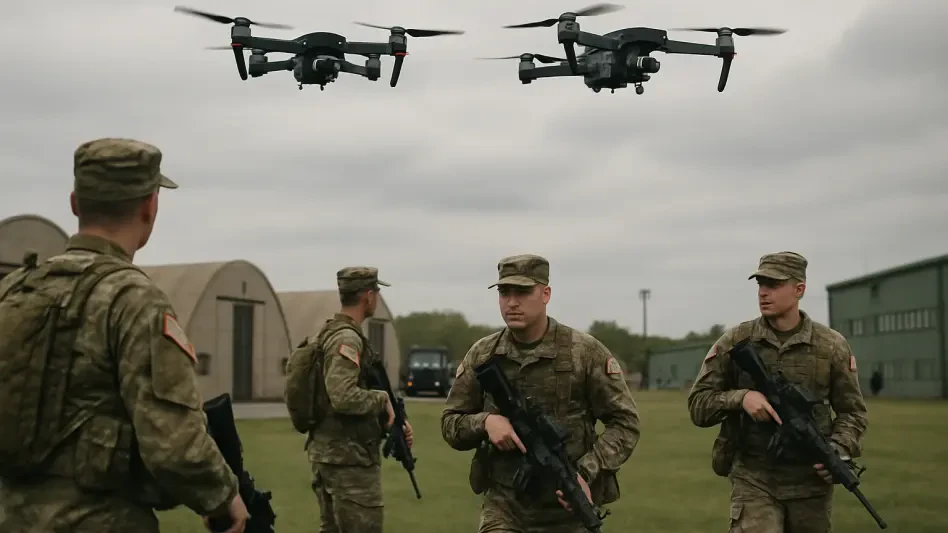What happens when the silent hum of a drone pierces the night sky above a heavily guarded military base? On a quiet Monday evening, unidentified drones were spotted hovering over France’s Mourmelon-le-Grand military base in the Marne department, a critical hub for national defense and international training operations. This alarming breach of restricted airspace has sent ripples of concern through military and government circles, exposing a vulnerability that technology seems to exploit with ease. The incident isn’t just a local anomaly; it’s a stark reminder of a growing threat that challenges the very foundations of security in Europe today.
A Silent Intrusion: Unraveling the Mourmelon-le-Grand Incident
The Mourmelon-le-Grand military base, home to the 501st tank regiment, has played a pivotal role in training Ukrainian soldiers under the Champagne task force since early 2025. On that Monday night, small unauthorized aircraft were detected in the airspace above, confirmed by military officials as not belonging to any sanctioned operations. The immediate response was to heighten security protocols to safeguard ongoing activities, though specifics about the drones remain undisclosed. This breach is no trivial matter. Restricted airspace over military installations is sacrosanct under French law, with violations carrying severe penalties, including hefty fines and potential imprisonment. The presence of these drones raises unsettling questions about how such intrusions could occur at a site of such strategic importance, especially during a time of heightened geopolitical tensions. The significance of this event extends beyond a single base. It serves as a wake-up call to the vulnerabilities that even the most fortified locations face in an era where small, commercially available technology can evade traditional defense mechanisms. With Europe on edge, this incident underscores the urgent need to address gaps in security before they are exploited further.
The Rising Drone Menace: A Continental Crisis
Across Europe, unauthorized drone sightings have become an escalating concern, far beyond the borders of France. In recent months, countries like Scandinavia, Poland, and the Baltic states have reported similar incidents over sensitive military and civilian sites. These breaches have led to significant disruptions, including temporary airport closures and increased air patrols to monitor and intercept rogue aircraft. French regulations are clear: civilian drones are strictly prohibited over military zones. Yet, the frequency of these violations suggests that enforcement alone isn’t enough. A 2025 report from a European defense think tank noted a 60% rise in documented drone incursions over restricted areas compared to the previous year, highlighting a trend that threatens national security on a broader scale. The implications are profound. These incidents expose critical weaknesses in protecting vital infrastructure, from military bases to civilian airports. As technology becomes more accessible, the risk of espionage, sabotage, or even accidental interference grows, pushing defense authorities to rethink strategies in a landscape where threats are no longer confined to traditional warfare.
Who’s Behind the Controls? Theories on Drone Origins
Speculation surrounds the identity and intent behind the drones at Mourmelon-le-Grand, with the base’s role in training Ukrainian forces adding a layer of complexity to the mystery. European and NATO officials have pointed to a pattern of similar intrusions across the continent, often linking them to potential state actors. A recurring theory involves Russia, with some labeling these as “hybrid attacks” designed to test defense responses and sow uncertainty. This theory isn’t without precedent. Over the past year, multiple reports from Baltic and Scandinavian nations have documented drone activity near military exercises and border regions, often coinciding with periods of heightened tension. A NATO spokesperson recently stated that such actions could be deliberate provocations, aimed at assessing reaction times and exploiting gaps in surveillance. While no concrete evidence has tied the Mourmelon-le-Grand incident to a specific culprit, the recurring nature of these events suggests a coordinated effort. Military analysts argue that whether state-sponsored or the work of rogue operators, the intent appears to be disruption, forcing European nations to divert resources and attention to an elusive threat.
Echoes of Alarm: Reactions from Experts and Officials
The response to the Mourmelon-le-Grand sighting has been swift, with military sources confirming tightened security measures at the base. However, details about the drones’ origins or capabilities remain under wraps, fueling speculation and concern among defense experts. A senior European security official noted that these incidents are likely part of a broader strategy to probe weaknesses, emphasizing the need for vigilance in an increasingly complex threat environment. NATO representatives have echoed similar sentiments, warning that drone incursions could be precursors to more aggressive actions if left unchecked. In a recent briefing, an alliance spokesperson highlighted that over 30 such events have been logged across member states since early 2025, signaling a pattern that demands a unified response. The urgency of the situation is palpable in discussions among policymakers, who are grappling with how to counter a threat that operates in the shadows. Beyond military circles, the civilian impact is also under scrutiny. Analysts point to the potential psychological toll on communities near affected sites, where the sight of unauthorized drones can erode trust in security systems. As one defense researcher put it, “This isn’t just about airspace; it’s about confidence in the institutions tasked with protection.”
Fortifying the Skies: Strategies to Combat Drone Threats
In the wake of the Mourmelon-le-Grand incident, the French military has launched a thorough investigation, though public updates remain limited. The focus is on identifying the source of the drones and understanding how they bypassed existing safeguards. Meanwhile, broader European efforts are gaining momentum, with an EU meeting scheduled for Friday to discuss a proposed “drone wall” initiative—a collaborative framework to protect critical infrastructure through shared technology and intelligence. Practical solutions are already on the table. Advanced detection systems, capable of identifying small drones at long distances, are being prioritized, alongside stricter airspace regulations to deter civilian misuse. Cross-border cooperation is also key, as threats often transcend national boundaries, requiring real-time data sharing to track and neutralize rogue aircraft effectively. The path forward involves a multi-layered approach. Defense budgets across Europe are increasingly allocating funds—projected to rise by 15% from 2025 to 2027—for anti-drone technology, while public awareness campaigns aim to educate citizens on the risks of unauthorized drone use. These steps, though promising, require time and coordination to close the gap between evolving threats and current capabilities.
Reflecting on a Hidden Danger
Looking back, the sighting of unauthorized drones over Mourmelon-le-Grand stood as a pivotal moment that exposed the fragility of even the most secure spaces. It highlighted how technology, once a tool for innovation, had turned into a double-edged sword, capable of undermining national defense with alarming ease. The incident became a catalyst for urgent dialogue among European nations, revealing the shared nature of a threat that knew no borders. The next steps demanded more than just reaction; they required anticipation. Strengthening defenses through advanced systems and international partnerships emerged as a clear priority, ensuring that such breaches would not recur unchecked. Beyond technology, fostering public trust through transparency and preparedness became equally vital, as communities needed reassurance that their safety remained paramount. Ultimately, the response to this challenge hinged on unity and innovation. By pooling resources and expertise, Europe aimed to build a resilient shield against aerial intrusions, turning a moment of vulnerability into a foundation for stronger security. The path ahead was complex, but with coordinated action, the skies could be safeguarded for generations to come.








